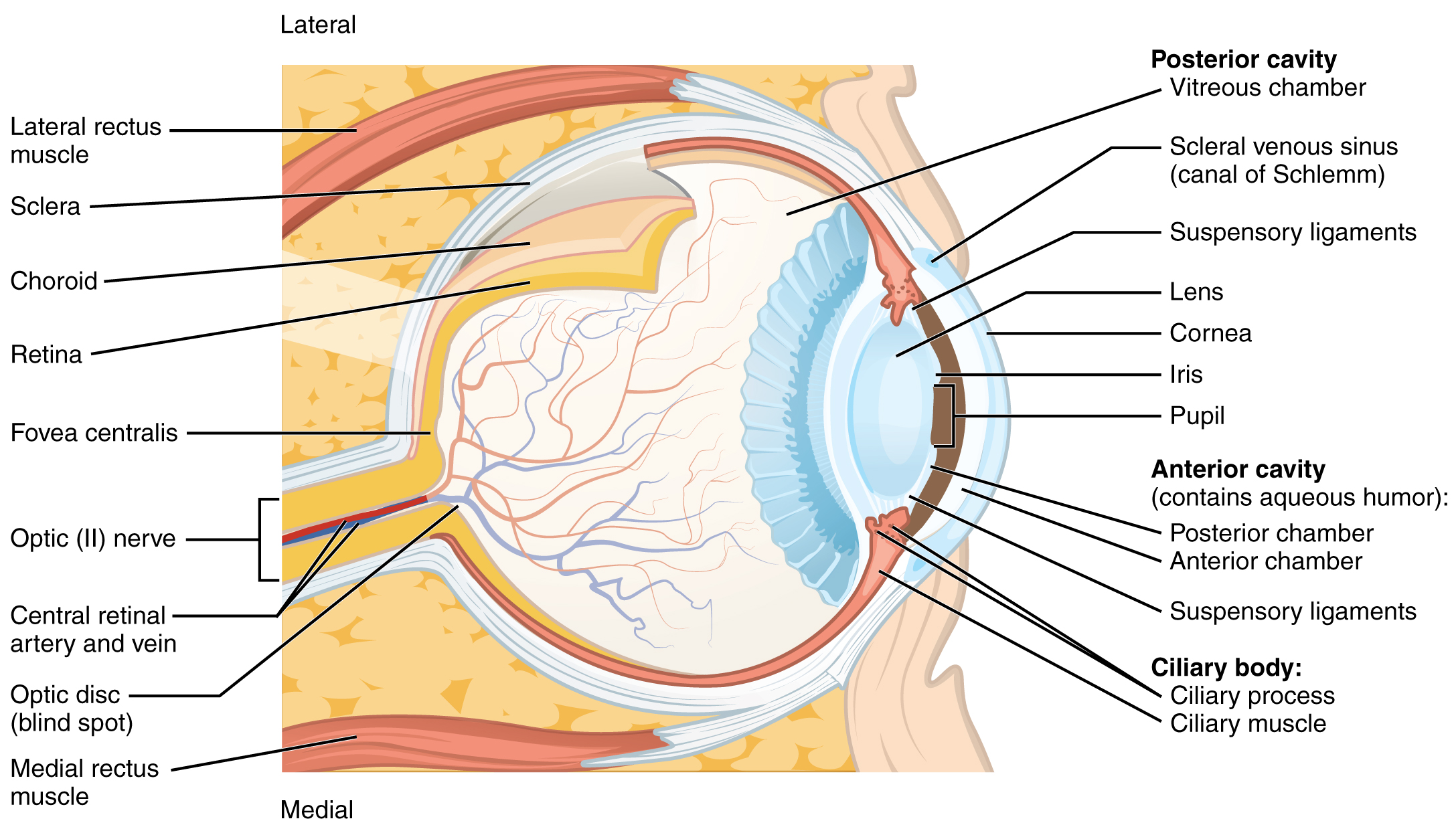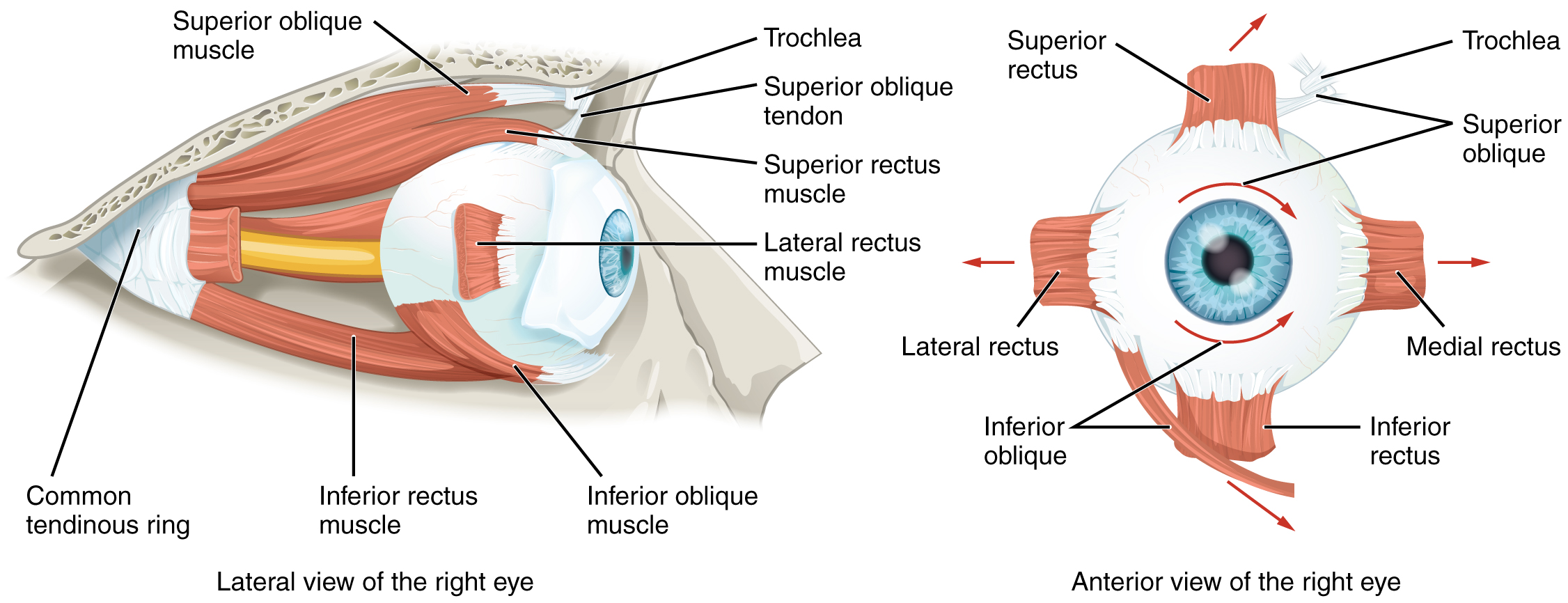Light and Eyeballs
82 Eyeball Anatomy
Learning Objectives
Being able to describe different parts of a human eyeball.
Know which parts of the eyeball are involved in accommodation.
Know what a blind spot on the retina is, and where it’s located.
Structure of the Eye
The eye is made up of various components that work together to guide and focus the right amount of light onto the retina. Light enters at the most anterior part of the eye and first passes through the cornea. The cornea is the transparent, curved structure at the front of the eye, with embedded nerve endings for pain, touch and thermal sensation. It has 80% of the focusing power of the eye, but is not flexible, so its power is fixed. Surrounding the cornea is the sclera which is the white, hard outside of the eyeball. After the cornea, light then passes through the aqueous humor, a low viscosity fluid behind the cornea, and then the pupil. The iris is the muscular, colored tissue surrounding the pupil that gives each individual their eye color. The iris is also able to open and close in response to lighting conditions, dilating (making bigger) and contracting (making smaller) the pupil, and so adjusting the amount of light let into the eye. Light next passes through the lens which is flexible and provides the remaining 20% of the focusing power of the eye. The lens is also able to change its shape (curvature) through the contraction and relaxation of ciliary muscles, which are attached to it. Light then enters the posterior cavity of the eye which is filled with highly viscous fluid called the vitreous humor.
Finally, light reaches the retina, a sheet of neurons at the back of the eye. The retina contains photoreceptors (cones and rods) which absorb light and transduce its energy to changes in neural signals takes that are eventually sent to the brain through the optic nerve (more on this in later sections). Located at a specific point near the center of the retina is the fovea, which has the highest density of photoreceptors of any retinal location. This density makes it the highest acuity region of the retina, i.e. where the finest detail can be accurately transmitted to the brain. When we look at something, our visual systems automatically move our eyes so that the fovea lands on it. The macula is the retinal area surrounding the fovea, and has slightly worse acuity. Further away from the fovea is the peripheral retina with even poorer acuity.
Importantly, the retina is build “upside-down” such that the photoreceptors are closest to the sclera, while the ganglion cells, the output cells of the retina are closes to the vitreous. This arrangement means the axons leaving the eyeball to get to the brain have to push through the photoreceptors; all the axons leaving the eyeball come together at one location, called the optic disc, where they bundle together to form the optic nerve and push through the rest of the retina and sclera to reach the brain. This causes a corresponding blind spot in each eye- a retinal location where there are no photoreceptors. Perceptually, the blind spot is hard to notice because our brains automatically “fill in” the missing information without our being aware of it, with a guess based upon what is visible surrounding the blind spot.
Other components of the eye that are important for maintaining function and mobility. At the back of the retina lies a single layer of cells called the pigment epithelium which is a dark layer behind the retina where visual pigments are regenerated. Behind that is the choroid, is a layer of highly vascularized connective tissue between the retina and sclera, which provides a specialized blood supply to the photoreceptors. There are also a variety of muscles that are responsible for eye movement. There are four main muscles arranged at the cardinal points around the eye called superior rectus, medial rectus, inferior rectus, and lateral rectus. Contraction of one of these muscles results in the eye moving toward the contracting muscle. There are also two muscles called superior oblique and inferior oblique which can rotate the eyes to keep them as aligned as possible.
Dysfunction in any one of these components the eye can lead to various degrees of vision loss or even blindness. One example of dysfunction is presbyopia, which is when the lens gets hard and can’t be squished by the ciliary muscles (a process called accommodation) to focus on things that are near. Although it is only 20% of the focusing power, losing this power causes vision to be blurry, and reading glasses may be needed to provide the extra power and allow objects close to the eye to be in focus. Another relatively common dysfunction are cataracts, in which a crystallization process makes the lens appear cloudy and scatters light, also making vision blurry.


Exercises
CC LICENSED CONTENT, SHARED PREVIOUSLY
OpenStax, Anatomy and Physiology Chapter 14.1 Sensory Perception
Provided by: Rice University.
Access for free at https://openstax.org/books/anatomy-and-physiology/pages/14-1-sensory-perception
License: CC-BY 4.0
Adapted by: Ran Rice
Cheryl Olman PSY 3031 Detailed Outline
Provided by: University of Minnesota
Download for free at http://vision.psych.umn.edu/users/caolman/courses/PSY3031/
License of original source: CC Attribution 4.0
Adapted by: Ran Rice and Jacob Powers

